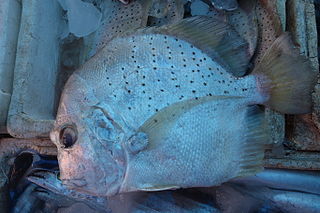
Pomfrets are scombriform fish belonging to the family Bramidae. The family currently includes 20 species across seven genera. Several species are important food sources for humans, especially Brama brama in South Asia. The earlier form of the pomfret's name was "pamflet", a word which probably ultimately comes from Portuguese pampo, referring to various fish such as the blue butterfish. The fish meat is white in color.

Hexagrammidae, the greenlings, is a family of marine ray-finned fishes belonging to the suborder Cottoidei in the order Perciformes. These fishes are found in the North Pacific Ocean.

The wreckfish are a small group of ray-finned fish in the genus Polyprion, belonging to the monotypic family Polyprionidae in the order Acropomatiformes.

Trichogaster is a genus of gouramis native to South Asia from Pakistan to Myanmar. It is the only genus in the monotypic subfamily Trichogastrinae as set out in the 5th Edition of Fishes of the World, although that book states that there are two genera, the other being Colisa which is treated as a synonym of Trichogaster by Fishbase and the Catalog of Fishes. Fishbase also places the genus in the Luciocephalinae. Species of this genus are very popular in the aquarium trade.

Drepane is a genus of marine and brackish water ray-finned fishes, known commonly as the sicklefishes. It is the only genus in the monotypic percomorph family Drepaneidae. These fish occur in the Indian and western Pacific Oceans, and in the eastern Atlantic near Africa.

The long-finned pike or yellowfin pike is a species of acropomatiform ray-finned fish, the only species in the genus Dinolestes, as well as the family Dinolestidae.

Dichistius is a genus of centrarchiform ray-finned fishes, the galjoen fishes, native to the Atlantic coast of southern Africa and the Indian Ocean coast of southern Africa. Growing to lengths of 80 cm (31 in) and 35 cm (14 in), both known species are popular commercial and game fishes.

Oplegnathus is currently the sole recognized genus in the knifejaw family (Oplegnathidae) of marine centrarchiform ray-finned fishes. The largest, the Cape knifejaw, can reach a maximum length around 90 cm (35 in). Knifejaws have teeth fused into a parrot-like beak in adulthood. They feed on barnacles and mollusks, and are fished commercially. They are native to the Indian and Pacific Oceans.

Percilia is a genus of perch-like ray-finned fish in the monogeneric family Perciliidae.

Glaucosoma, the pearl perches, are ray-finned fishes native to the Indian Ocean waters around Australia and the western Pacific Ocean. This genus is currently the only one assigned to the family Glaucosomatidae.
Lipogenys gillii, the blackfin tapirfish, is a species of spiny eel in the family Notacanthidae, the only member of its genus. It is a benthic deep-sea fish occurring along the eastern coast of North America and in the southwestern Pacific near Australia at depths from 400 to 2,000 m.
Polyacanthonotus is a genus of spiny eels, with these currently recognized species:

Lateolabrax is a genus of commercially important ray-finned fishes known as the Asian seabasses. It is the only genus in the family Lateolabracidae. This genus is native to the coastal waters of the western Pacific Ocean. This genus has also been included in family Moronidae and may be nested within the Polyprionidae.

Brotula is a genus of cusk-eels. It is the only genus in the subfamily Brotulinae.

Fodiator is a genus of flying fishes. It is the only genus in the subfamily Fodiatorinae.

Parabembras is a genus of marine ray-finned fish belonging to the family Bembridae, the deepwater flatheads, although they are sufficiently different from the other genera in that family to be classified as their own family, Parabembradidae, by some authorities. These fishes are found in the Indian Ocean and the western Pacific Ocean.

Kyphosus is a genus of sea chubs native to the Atlantic, Indian and Pacific oceans.

The Alosidae, or the shads, are a family of clupeiform fishes. The family currently comprises four genera worldwide, and about 32 species.

Banjos is a genus of marine ray-finned fish, the only genus in the monotypic family Banjosidae, which is part of the order Acropomatiformes. They are native to the western Indian and the Atlantic coasts of Africa, and is made up of the three species of banjofishes.

The ara, otherwise known as the saw-edged perch or the Dageumbari (다금바리) is a species of marine ray-finned fish from the monospecific genus Niphon in the monogeneric family Niphonidae. It is found in the Western Pacific Ocean from Japan south to the Philippines where it inhabits rock reefs and inshore waters with rocky sea beds. This species can grow up to 1 metre (3.3 ft) in total length. The ara was first formally described in 1828 by Georges Cuvier in the Histoire naturelle des poissons which he co-authored with Achille Valenciennes, the type locality was given as the Sea of Japan.


















